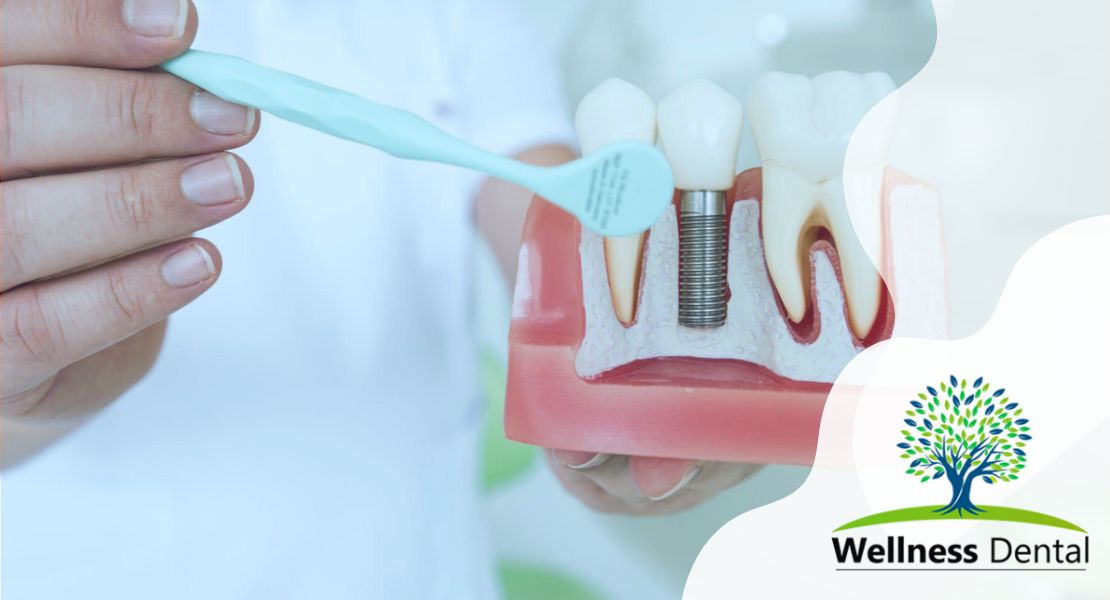When faced with an infected dental implant, you may wonder if it’s possible to save it. The good news is that the fate of the implant can be determined by various factors, including the stage of infection and the extent of bone loss.
In the early stages of infection, non-surgical treatment options may be considered. This can include thorough mechanical cleaning to remove plaque and bacteria buildup around the implant. Additionally, improving oral hygiene routine, such as regular brushing and flossing, can aid in preventing further infection.
However, in more advanced cases where the infection has caused significant bone loss or the implant is loose, surgical treatment may be necessary. This can involve removing the implant, addressing any underlying gum disease or infection, and potentially performing bone grafting procedures to restore lost bone tissue.
Early detection is key in saving an infected dental implant. Regular check-ups with your dental professional can help identify any signs of infection or inflammation. Prompt treatment can increase the likelihood of saving the implant and preventing further complications.
In conclusion, while it is possible to save an infected dental implant, the success of treatment depends on several factors. Seeking early detection and taking appropriate non-surgical or surgical treatment options can help restore oral health and prevent implant failure.
Diagnosing an Infected Dental Implant

Diagnosing an infected dental implant involves several steps to accurately assess the extent of the infection and determine the appropriate treatment plan. Regular dental checkups play a crucial role in the early detection of such infections.
To diagnose a possible implant infection, a dental X-ray is taken. This helps the dentist evaluate the implant’s surrounding bone for any signs of infection. Bone loss around the implant suggests an infection. X-rays also help assess the implant’s position and stability.
In addition to the X-ray, the dentist may gently probe the area around the implant using a specialized instrument. This probing helps assess the level of inflammation and infection present. The dentist will look for signs such as bleeding, swelling, pus, or mobility of the implant. Any discomfort or pain in the implant area may also indicate an infection.
Regular dental checkups are essential for the early detection of dental implant infections. During these routine visits, the dentist will thoroughly examine the implant, evaluate the surrounding gum tissue, and take X-rays periodically. Detecting the infection in its early stages increases the chances of saving the implant and preventing further complications.
If an infected implant is diagnosed, prompt treatment is necessary to prevent further damage and potential implant failure. Your dental professional will provide appropriate treatment options based on the severity of the infection and the extent of bone loss.
Regular dental checkups are vital for early detection, allowing for prompt treatment and better chances of saving the implant.
Signs of a potential infection in your dental implant

If you have a dental implant, it is important to be aware of the signs and symptoms that may indicate an infection. The following are common signs to look out for:
1. Bad Breath: A persistent and unpleasant odor coming from your mouth, despite maintaining proper oral hygiene, could be a sign of an infected dental implant.
2. Bleeding or Pus in the Gum Tissue: If you notice any bleeding or discharge of pus around the gum tissue surrounding your implant, it may indicate an infection.
3. Red or Swollen Gums: Inflammation of the gums around the dental implant is a common sign of infection. Redness and swelling in the area should not be ignored.
4. Pain or Tenderness: If you experience pain or tenderness around the implant site, it could be a sign of infection. Discomfort while chewing or applying pressure is also an indication to watch for.
5. Difficulty Chewing: If you suddenly find it difficult to chew or bite down properly, it may be due to an infected dental implant.
6. Loose or Shifting Implant: A loose or wobbly implant is a clear sign that there may be an infection present.
Furthermore, if you have an unexplained fever, it is essential to consult your dental professional as it may be associated with a severe infection.
Being aware of these signs and symptoms is crucial in identifying and treating implant infections at an early stage. If you observe any of these signs, make sure to schedule an appointment with your dentist promptly. Early diagnosis and proper treatment can help save your dental implant and prevent further complications.
Treating Dental Implant Infection
The treatment of an infected dental implant is determined based on the severity and extent of the infection. A dentist will evaluate the condition and recommend the appropriate treatment options, which may include antibiotics, debridement, or surgical intervention, in order to restore oral health.
Antibiotics: Antibiotics are usually prescribed if the infection is mild to moderate. Depending on the extent of infection, different antibiotics may be used. Typically, a course of antibiotics for at least two weeks is recommended to clear up any existing bacteria in your mouth.
Debridement: Debridement involves removing bacteria, plaque, and debris from around the implant site. This can help reduce inflammation and pain. In some cases, a local anesthetic may be used to ensure comfort during the procedure.
Surgical Intervention: In severe cases, surgical intervention may be required to treat the infection. This involves removing any infected tissue or bone and replacing it with healthy tissue or bone grafts. Your dental professional will discuss the best course of treatment for your condition before proceeding with any type of surgery.
Discover the Solution: Dealing with a Potential Dental Implant Infection
If there is suspicion of a dental implant infection, it is important to seek professional assistance from a dentist promptly. Neglecting the issue and hoping it resolves itself can result in additional complications and potential implant failure.
Antibiotics:
Antibiotics play a crucial role in the treatment of dental implant infections. Depending on the extent of the infection and the presence of other oral diseases, antibiotics can be administered locally or systemically.
For localized treatment of dental implant infections, antibiotics such as tetracycline and metronidazole are commonly used. Tetracycline is effective against a wide range of bacteria and can be used as a topical gel or powder applied directly to the infected area. Metronidazole, on the other hand, is particularly effective against anaerobic bacteria commonly associated with dental infections.
Systemic antibiotics may be prescribed for more severe cases of dental implant infection, such as in peri-implantitis, where the infection has spread to the surrounding tissues. Commonly used antibiotics for systemic treatment include amoxicillin, clindamycin, and azithromycin. These antibiotics are effective against a broader range of bacteria and are typically taken orally.
It is important to note that antibiotics alone cannot fully resolve dental implant infections. They should be used in conjunction with other treatment methods, such as mechanical cleaning and oral hygiene practices, to achieve optimal results. Additionally, the use of antibiotics should be guided by a dental professional to ensure appropriateness and effectiveness.
In conclusion, antibiotics are an important tool in the treatment of dental implant infections. Whether administered locally or systemically, they play a crucial role in combating the infection and promoting healing. However, it is essential to use antibiotics in conjunction with other treatment methods and under the guidance of a dental professional for the best possible outcomes.
Mechanical cleaning:
Mechanical cleaning plays a crucial role in the treatment of an infected dental implant. This process involves the physical removal of plaque and bacteria from the implant and surrounding tissues to eliminate the source of infection.
For shallow mucosal pockets, ultrasonic devices or carbon fiber curettes are commonly used. Ultrasonic devices utilize high-frequency vibrations to break down and remove plaque and bacteria from the implant surfaces and the pocket walls. Carbon fiber curettes, on the other hand, are delicate instruments that can effectively clean shallow pockets without causing damage to the implant.
In the case of deep pockets, delicate scaling instruments or mechanical flossing may be employed. These instruments enable the thorough cleaning of hard-to-reach areas around the implant. Proper technique is essential to ensure effective cleaning without roughening the implant surface, which could lead to further complications.
In some cases, a locally administered antiseptic may be necessary to enhance the effectiveness of mechanical cleaning. This aids in killing remaining bacteria and preventing further infection.
Mechanical cleaning, in combination with good oral hygiene practices, is crucial for the successful resolution of dental implant infections. Regular professional cleanings and diligent oral care routine can help prevent future infections and maintain the longevity of dental implants.
Surgery:
Surgery is sometimes required for the treatment of dental implant infections that cannot be resolved through non-surgical techniques. The surgical treatment process typically involves the following steps:
- Incision: An incision is made in the gum tissue surrounding the infected dental implant to access the affected area.
- Implant removal: The infected implant is carefully removed from the bone and surrounding soft tissues. This allows for thorough cleaning of the area and evaluation of the extent of the infection.
- Debridement: The infected tissues and any pus or debris are carefully removed from the area. This helps eliminate the source of the infection and promotes healing.
- Bone grafting: In some cases, bone loss may have occurred due to the infection. To address this, a bone graft may be performed to regenerate the lost bone tissue. This helps to provide a stable foundation for the replacement implant.
- Antibiotic therapy: Antibiotics may be prescribed to control the infection and prevent its spread following surgery.
During the surgical procedure, mechanical cleaning is crucial for removing bacteria and plaque from the implant surfaces and surrounding tissues. This step helps eliminate the source of infection and reduces the risk of reinfection. Additionally, the use of antiseptics during surgery can further enhance the effectiveness of cleaning by killing remaining bacteria.
Potential complications following surgical treatment for dental implant infection include post-operative pain, swelling, bleeding, and bruising. In some cases, the infection may persist or recur, requiring further treatment. Other complications may include implant failure, nerve damage, and delayed healing.
It is important for patients to follow their oral surgeon’s instructions for post-operative care and maintain proper oral hygiene practices to minimize the risk of complications and promote successful healing.
Implant removal:
Implant removal is a surgical procedure performed to address infected dental implants that are causing complications such as significant bone loss or damage. When an implant becomes infected, it can lead to inflammation, bone loss, and potential implant failure if left untreated.
During the implant removal procedure, various surgical instruments may be utilized depending on the amount of supporting bone remaining. A trephine, for instance, may be used when there is minimal bone loss to effectively remove the implant. Forceps, on the other hand, may be employed if there is extensive bone loss, allowing for careful removal without causing further damage.
In cases where bone loss has occurred, a bone grafting procedure may be necessary to regenerate the lost bone tissue. This helps provide a stable foundation for possible reimplantation after the area has healed. However, in some situations, another dental implant procedure may be required to replace the infected implant.
It is important to note that the decision to reimplant will depend on various factors, including the severity of infection, amount of remaining bone, and the individual patient’s circumstances. Consulting with a dental professional is crucial to determine the most suitable treatment plan for each case of infected dental implants.






